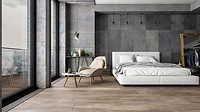Do Walls Really Have to be Flat and Plumb?

This photo indicates two critical issues: the level placed against the wall indicates a low spot of approximately 3/4”, and the wall is out of plumb by 1/2” in 10’. The combination of these two problems makes the low spot in the middle of the wall about 1-1/4” which is 10 times greater than the ANSI requirement of 1/8" in 10’ for large format tile 15" or longer.
Photo by Scott Carothers.
When the time comes to physically look at a potential job, there are many aspects of the project that must be reviewed. Of course, measurement need to be taken and site conditions determined, but there are several aspects that if neglected, the job can become a financial disaster. One that can easily be overlooked is the condition of the walls.
The standards for ceramic tile installation, ANSI A108.02 list the following requirements:
Section 4.1 states; Prior to commencing ceramic tilework, the tile contractor shall inspect surfaces to receive tile and accessories, and shall notify the architect, general contractor, or other designated author in writing of any visually obvious defects or conditions that will prevent a satisfactory tile installation. Installation work shall not proceed until satisfactory conditions are provided.”
Section 4.1.4 states, in part; “Surfaces to receive tile shall be plumb, level, and true with square corners.”
Section 4.1.4.3.2 Vertical surfaces states, in part; For tiles with at least one edge 15 in. (0.38m) or longer, the maximum allowable variation is no more than 1/8 in. in 10 ft. (3 mm in 3 m) and no more than 1/16 in. in 2 ft. (1.6 mm in 0.6 m) from the required plane, when measured from the high points in the surface.
The attached photo clearly indicates two very critical issues, which are necessary for a successful job, are missing. The level placed against the wall indicates a low spot of approximately ¾”, but the additional problem is that the wall is out of plumb by ½” in 10’. The combination of these two problems makes the low spot in the middle of the wall about 1-1/4” which is 10-times greater than the ANSI requirement of 1/8 in. in 10’ for large format tile 15 in. or longer.
Beyond being outside the ANSI requirement, this low spot will cause excessive and unacceptable lippage from one tile to the next, and the problem doesn’t stop there. When the tile on the left side wall meets the tile on the back wall, the cuts at the bottom of the wall will be 1-1/4” shorter than the ones at the top of the wall. Depending on the size of the cuts on the back wall, a very visible and undesirable sliver will advertise this mistake forever.
When problems of this type show up on a jobsite, use the ANSI standards to your advantage. Notify the appropriate person(s) of these industry standards and stand firm with what you know is required for a good installation. Don’t let someone talk you into doing what you know will not be acceptable. If you do, you will pay the price of doing it again.
Looking for a reprint of this article?
From high-res PDFs to custom plaques, order your copy today!









